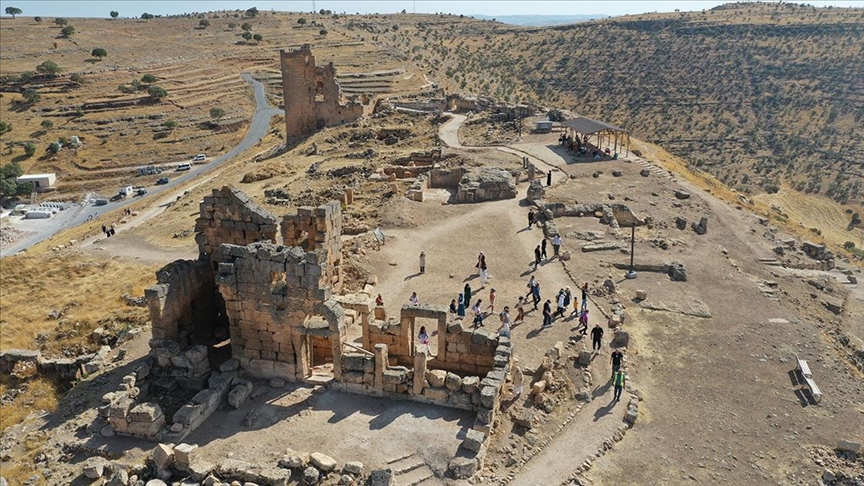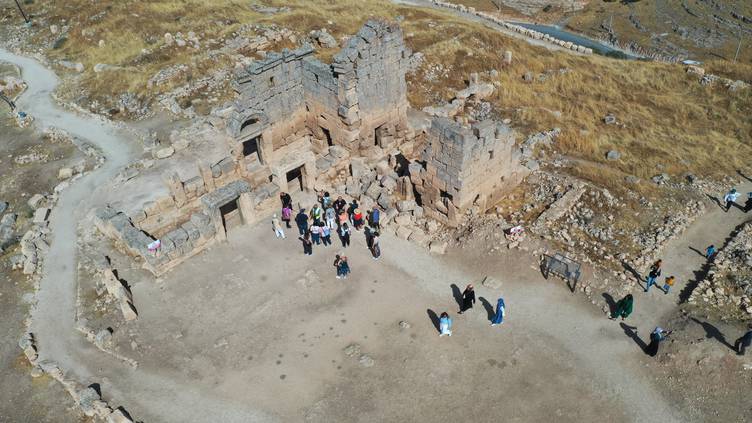
The monumental gate of the 1,900-year-old Mithras Temple in Zerzevan Fortress has been reached
The site of the main entrance gate of the 1,900-year-old underground temple belonging to the Mithras religion has been determined during excavations at Zerzevan Fortress in the Çınar district of Diyarbakır.
The Zerzevan Fortress, used as a border garrison during the Roman Empire, is believed to have its origins in a fortress known as Kinabu in the Assyrian period, although the exact period of its initial construction is uncertain. It is thought that this fortress was also utilized during the Persian period. The ancient name of Zerzevan Fortress is most likely Samachi.
Excavations started in 2014 at Zerzevan Castle, which is on the UNESCO World Heritage Temporary List, continue.
During the excavations that have continued to date, various structures have been unearthed in an area of 60 acres. These include the remains of walls 12-15 meters high and 1200 meters long, a 21 meter high observation and defense tower, a church, administrative buildings, residences, granaries, weapon depots, rock tombs, water channels, 54 water cisterns, and an underground. There is a church, an underground shelter for 400 people, residences, secret passages and an underground temple related to the Mithras cult of the period. As its importance decreased after the adoption of Christianity in the 4th century AD, various works were unearthed.
📣 Our WhatsApp channel is now LIVE! Stay up-to-date with the latest news and updates, just click here to follow us on WhatsApp and never miss a thing!!

During this year’s excavation efforts, the monumental main entrance gate of the Mithras Temple and multiple structures beneath the temple were discovered.
Head of Excavation Assoc. Dr. Aytaç Coşkun, speaking to an AA reporter, emphasized that the fortress holds a historical dating back 3,000 years, marking the completion of the 9th season of archaeological excavation and restoration efforts.
Coşkun highlighted the ongoing excavations at various points within the fortress, expressing a particular focus on the “Mithras sacred area” this year.
He described discovering new areas within the temple and stated, “We have identified one of the most significant areas where ceremonies commenced in the 1,900-year-old sacred site, intensifying our efforts there. We continue our work both at the monumental entrance gate of the sacred area and at the accommodations for the Mithraists attending the rituals. We are currently working on the upper part of the sacred area. We’ve identified numerous structures underground. We’ve initiated work both above and below ground. Mithras, in fact , constitutes a vast complex. There are lodging areas around the temple. All rituals and ceremonies in the mystery cult of Rome were conducted in secrecy. Several structures have been detected beneath the fortress using ground-penetrating radar. The structures within the sacred area served “For religious purposes, while those inside the fortress were utilized as food storage and shelters during times of war.”
Cover Photo: AA
You may also like
- A 1700-year-old statue of Pan unearthed during the excavations at Polyeuktos in İstanbul
- The granary was found in the ancient city of Sebaste, founded by the first Roman emperor Augustus
- Donalar Kale Kapı Rock Tomb or Donalar Rock Tomb
- Theater emerges as works continue in ancient city of Perinthos
- Urartian King Argishti’s bronze shield revealed the name of an unknown country
- The religious center of Lycia, the ancient city of Letoon
- Who were the Luwians?
- A new study brings a fresh perspective on the Anatolian origin of the Indo-European languages
- Perhaps the oldest thermal treatment center in the world, which has been in continuous use for 2000 years -Basilica Therma Roman Bath or King’s Daughter-
- The largest synagogue of the ancient world, located in the ancient city of Sardis, is being restored











Leave a Reply